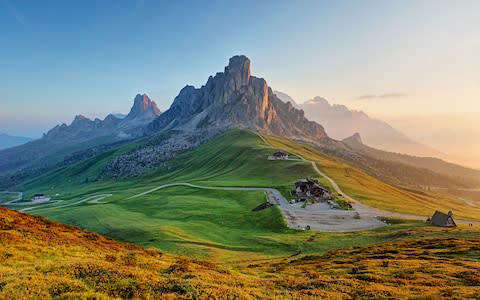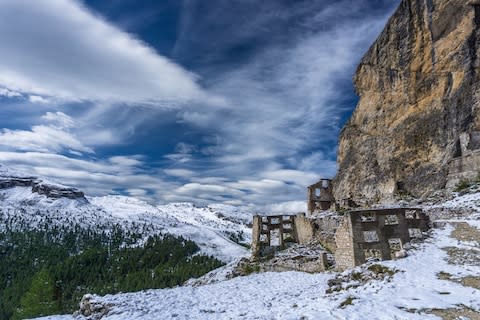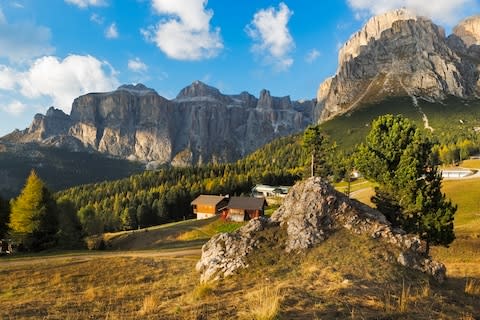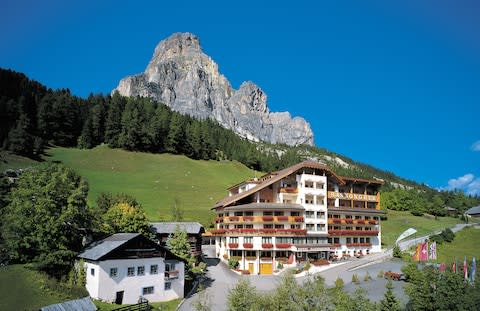Is this the world's most beautiful bike route?

Keen London cyclists - you know, the kind who wander around in lycra and silly caps - spend an awful lot of time going round in circles. Laps - of Regent’s Park or Richmond Park, more often than not - are a mind-numbingly dull yet inescapable part of the capital’s two-wheeled culture. One Wednesday last summer, however, while my cycling buddies were dodging traffic on Regent’s Park’s Outer Circle, I was discovering the most beautiful lap in the world.
It’s around 30 miles in length, so just one or two turns should keep you happy. But it offers the chance to circumnavigate a colossal massif of jagged limestone peaks and impossibly green pastures, cross four mountain passes (three of which are higher than 2,000 metres), and tackle almost 100 adrenaline-pumping hairpins – all before lunch.
As you’ve no doubt guessed, this gem is not found in south-east England, nor even Britain, but Italy’s Dolomites. It is the Sellaronda, a lap of such spectacular beauty that it’s hard to believe so few of my fellow cyclists have even heard of it, let alone sampled its joys.
Many skiers are familiar with it, however. The Sellaronda is a well established part of the winter holiday scene, and in colder months the same route is conquered by thousands of them (with the help of a few lifts, of course). Tourist chiefs, to keep the euros rolling in through summer, have had the bright idea to market the circuit to those who prefer to reach mountain passes using pedal power before they fly down the other side.
For a few days each year these roads are clogged with bicycles. The annual Sellaronda Bike Day, held in June, sees 24,000 cyclists of all ages and abilities, complete the loop. In July, 9,000 particularly masochistic athletes arrive for the Maratona dles Dolomites, which includes the Sellaronda – plus a further 50 miles over three more passes. And the Giro d’Italia, one of the three Grand Tours of cycling, which is currently underway, usually visits – bringing with it 200 professionals and scores of tifosi. But come on any other day between May and October and you’ll find far more hikers than riders – in stark contrast to the crowded roads of cycling honeypots like Mallorca. The secret isn’t quite out.

The relative inaccessibility of the range is one reason why. The nearest airports are in Venice, from where it’s three to four hours by car to Corvara, the most logical and picturesque base on the Sellaronda route. This can make independent trips - particularly for groups like us - a bit of a faff. Luckily, there is no shortage of specialist tour operators - such as Love Velo, which sends Brits to Corvara each year for the Maratona - ready to whisk you from arrivals hall to Dolomites, and organise your hotel and bike hire.
On the road north from Venice, it doesn’t take long for the landscape to start reaching skyward. Our excited chatter increases as we watch the fertile flatlands of Veneto morph into spectacular peaks tinged pink in the fading evening light. For six cyclists accustomed to weekdays turning circles in central London, and weekend rides up Surrey’s meagre hills, the anticipation is unbearable.
There is just one nagging doubt: the weather. Having endured a hellishly wet week in the French Pyrenees last summer, the climate of the Dolomites has enticed us. Nowhere in the Alps has less rainfall or more sunshine. Or so the tourist board claims. In the week leading up to our departure, the forecasts (BBC, Met Office, you name it) are unequivocal: brace yourselves for a week of thunderstorms. Memories of that “summer” in France - where we were been soaked on every climb, lashed by wind at the summits, and chilled to the bone on each descent, forcing us to seek shelter in cafés that were inevitably closed - come flooding back. Our concierge, however, provides not just room keys but deliverance. The forecast on his mobile app comes from a local source, and displays nought but sunshine. A state of delirium spreads amongst the group as we settle down to bed. Don’t trust the Met Office.
We decide to save the Sellaronda for last. So our first ride takes us north, through the ski town of Badia, up and over the Passo delle Erbe and into the Val di Funes. If you’ve not heard of this valley, you’ll probably recognise it. Google “Dolomites” and the first photo you see will probably show the church of Santa Magdalena, which lies at its heart. It is truly the stuff of travel brochures. Lush meadows, clusters of timber-framed houses, and pockets of forest, all lorded over by the most eye-catching mountains anywhere on the planet. So irregular is the rock, and so spectacular the formations, that every corner offers a slightly different vista, and every crest brings a fresh canvas. It is the sort of backdrop that has you grinning from ear to ear, even on the steepest slopes, and whooping in delight (quite literally) on the descents. I may occasionally tire of London, but I could never tire of staring at the Dolomites.

The Val di Funes is billed as one of the hidden gems of the region – and it lives up to the hype. For two hours, from the foot of the Passo delle Erbe to our lunch stop at the little town of San Pietro, we barely see a soul - and not a single cyclist. Just cows ringing their bells and the odd whistling marmot.
Our return to Corvara takes us over a spiteful little climb to the forgotten village of Freina, before a sharp descent and a long drag east up the Val Gardena. Spectacular scenery tends to dull the pain in your legs. But by the time we reach the Gardena Pass, and with more than 60 miles and 4,000 metres of climbing in the bank, I am in a state of distress. Time for some après.
A post shared by Olly Smith (@oliver_smith_83) on Aug 21, 2018 at 8:57am PDT
The sight of stout wooden chalets provides the first clue - followed by the umlauts on the road signs (the Passo delle Erbe is also known by the rather less melodic moniker “Würzjoch”) – that this might be a region of Italy but, thanks to its Habsburg heritage, it has a decidedly Austrian character. The result is restaurants that proffer some delightfully hearty cross-border combinations. Beer served in a two-pint stein followed by a towering bowl of gnocchi? Or how about a platter of speck and cheese washed down with an Aperol spritz? All of which makes it a stand-out choice for desperately refuelling cyclists.

Where après-ski keeps winter bartenders busy till the early hours, après-cycle is a very different beast – much to the annoyance, I suspect, of Corvara’s publicans. It starts in much the same way. The satisfaction of burning several thousand calories is matched only by the gluttonous rebalancing of said deficit. But the evening brings with it a wall of fatigue – and it’s inevitably lights out by 10pm.
The Dolomites does famous climbs as well as unknown corners, and none of its peaks is more storied than the Giau, which we tackle on day two. Five times it has featured in the Giro d’Italia, and each time it has left its mark on the race, scuppering the hopes of grizzled pros and thrusting others up the leaderboard. It is undoubtedly the hardest ascent in the region, a seven-mile grind with a gradient that clings resolutely to an exhausting 10 per cent, but offers a reward like no other. The pass, and, thankfully, a welcoming cafe, sits in a vast pasture at the foot of the soaring Nuvolau and Averau mountains - their sheer faces so typical of the range, and offering views of perhaps a dozen more. It is an epic location, and mystifyingly beautiful – no wonder that the Giau’s surroundings feature so prominently in the legendary literature of the Ladin people, native to this sliver of Europe.

The return to Corvara takes us up and over the Valparola pass, where a more brutal modern narrative is told. It is home to the Forte Tre Sassi, built by the Austrians in 1901, bombed by the Italians in 1915 - and now a museum dedicated to the First World War’s often overlooked Italian Front. A million troops died in this high-altitude, sub-zero theatre of conflict, many buried in avalanches or mown down by machine-gun fire attempting futile uphill assaults in what Ernest Hemingway called “the most colossal, murderous, mismanaged butchery” of the entire saga.

After two hefty days in the saddle, the long-awaited Sellaronda feels like something of a rest day – despite the four passes. We rise early, climbing the first - the Gardena - in ethereal conditions, a low mist hugging the valley floor and creeping up the mountainsides. The second - the Sella - tops out at a lofty 2,218m, and is, to my eye, the most photogenic. The enjoyment of the views - the four Sella Towers to the left, the peaks of the Langkofel Group to the right - is hindered only by the distinct shortage of oxygen. Third up is the Pordoi, higher still at 2,239m, reached via a snaking tree-shrouded road, and topped with a memorial to Italy’s greatest professional cyclist, Fausto Coppi.

Last up is the shortest of the four - the Campolongo - before a helter-skelter ride back into town. It has been three hours of bliss, and we envy the local cyclists who have this on their doorstep – and not Richmond Park. We check our watches. Having set out at 8am, we are back in Corvara by 11am. A few hours until lunch… then, one more lap?
How to get there
Oliver Smith travelled with Love Velo, which organises cycling trips to destinations across Europe and beyond. A four-night tour, offering the chance to tackle the 2019 Maratona dles Dolomites sportive, as well as two guided rides in the area, costs from £595 per person, including accommodation and transfers (flights extra).
The nearest airports to Corvara are Venice Marco Polo and Venice Treviso. British Airways and Ryanair offer flights from the UK.

Where to stay
Corvara’s five-star Hotel Sassongher is a fair contender for the greatest cycling hotel in the world. Not only is it on the Sellaronda route, but it offers vast top-notch breakfast buffets, sumptuous four-course dinners in a pleasantly formal setting (the waiters still wear bow ties), an old school cocktail bar headed by a mischievous old Italian waiter, and a plush spa offering saunas and rub-downs. Doubles from €350 per night, half-board. See sassongher.it.



